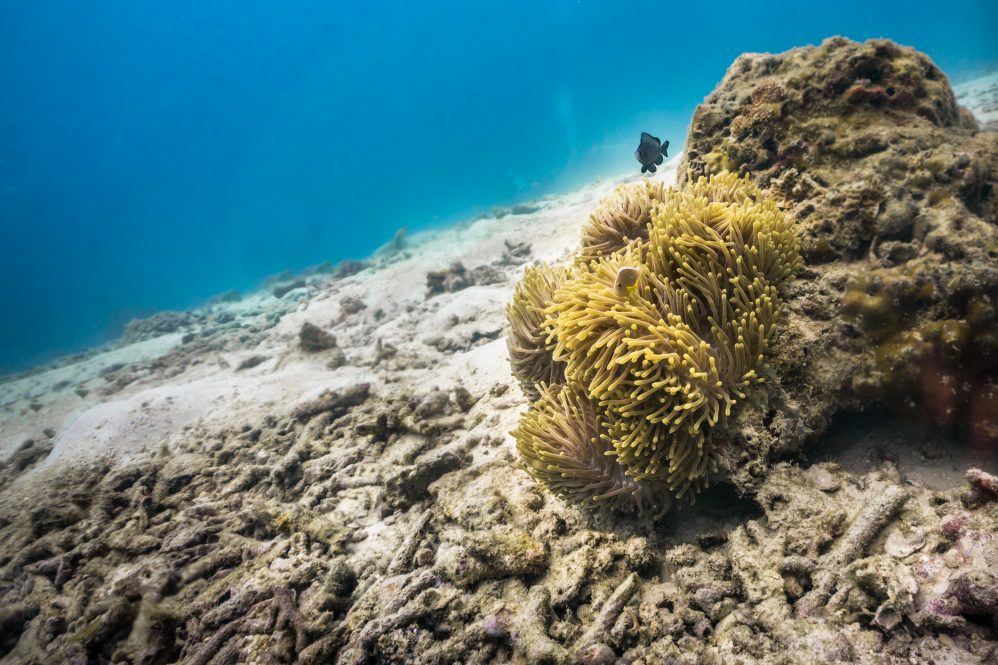On our planet, the cycle and balance of carbon from reservoir to reservoir is a matter of life or death. Carbon moves from the atmosphere to the ocean, to carbon-based life forms, to rocks or sediments, and it can be tied up in any of these reservoirs throughout the process.
Imbalances within the cycle can have dramatic global impacts. For example, too much carbon in the atmosphere leads to the greenhouse effect and global warming, and too much carbon in the ocean leads to ocean acidification, which compromises conditions for marine life. How does the Earth recover from catastrophic conditions like massive volcanic eruptions?
Researchers look to extremes in the past to study how the system reacts to imbalances. In their paper published in Nature, researchers from the University of Connecticut, University of Victoria, Yale University, University of British Columbia, and Georgia Institute of Technology detail an overlooked mechanism for how the ocean can help stabilize massive releases of carbon into the atmosphere following volcanic eruptions.
UConn Department of Earth Sciences assistant professor and the paper’s lead author Mojtaba Fakhraee says a simplified way of imagining the global carbon cycle starts with an eruption of volcanic gases that release carbon into the atmosphere. Those forms of carbon like CO2 may remain in the atmosphere, whereas some can react with other elements to produce chemical species like dissolved inorganic carbon, that would be carried via rivers to the ocean.
“When the oceanic carbon balances out with the amount of CO2 in the atmosphere, they reach an equilibrium condition where the amount of CO2 in the atmosphere would be proportional to the amount of dissolved carbon species in the ocean,” says Fakhraee.
However, in times of extreme imbalance, like during climate catastrophes or when huge quantities of CO2 are released into the atmosphere, researchers found that a different type of feedback kicks in.
“The feedback happens when the ocean loses oxygen, it becomes more basic, and another type of reaction becomes more dominant under low oxygen or anoxic conditions. That reaction is anaerobic respiration, which produces sulfur species,” says Fakhraee.
The sulfur species formed by the reaction is iron sulfide or pyrite, which is also known as “fool’s gold.” The process has an overall buffering effect that preserves the alkalinity of the water and thus prevents it from becoming more acidic.
Researchers made this discovery using a coupled global carbon-sulfur cycle model that simulates geochemical processes over the past several hundred million years, including several ocean anoxic events (OAEs) and massive volcanic eruptions that released large amounts of carbon into the atmosphere. They found the production and burial of pyrite during OAEs had a substantial stabilizing effect during times of increased volcanic activity, thus buffering the oceans and playing a significant stabilizing role for millions of years.
“What it means is, the more you get of this buffering species, the more resistant the ocean becomes to change in pH and ocean acidification. This reaction is important in terms of how the ocean becomes resistant to acidification and changing pH,” says Fakhraee.
These reactions happen over a very long time, when the oceans of the past periodically experienced huge influxes of volcanic gases, resulting in deoxygenation and anoxic conditions, says Fakhraee, and that is when the models showed the increase in the iron sulfide reaction, increased alkalinity, and climate stabilization.
“We found it to be quite convincing to see why some of these past oceanic anoxic events were able to recover the way they did,” says Fakhraee. “Anoxic conditions were always thought of as a big problem for the oceans, but on a longer time scale this big problem can actually be a good way for the ocean and the whole earth to survive. Not everything about anoxia and oxygen loss is bad for the Earth system.”
There are also important implications to the carbon cycle of today, says Fakhraee, when we are seeing deoxygenation in the ocean as atmospheric levels of CO2 increase, but there is a caveat – time.
“We expect this process of iron sulfide formation to be important as we increase the rate of ocean deoxygenation, which would help regulate and stabilize the CO2 in the atmosphere. But do not make a mistake and think that this will help us with current climate change, because this feedback happens on a longer time scale. Humans would be drastically affected by climate change, but the Earth system has this intriguing feedback that would help the system to recover,” says Fakhraee.
Although pyrite formation occurs today in some anoxic marine environments, its global impact on ocean alkalinity and carbon sequestration is minimal under current conditions. A significant uptick in this buffering mechanism would require extensive, sustained deoxygenation of the global ocean — conditions that would be catastrophic for most marine life and profoundly disruptive to the Earth’s biosphere.
“Humans and other life experiencing climate change would be severely impacted over a very short time scale. It’s all about the time scale and then how much oxygen loss happens,” says Fakhraee.
Another important takeaway from this research that Fakhraee reflects on is the remarkable resilience of the global carbon cycle.
“All these interconnected processes show where one small change in one part of this whole system would make a large change in another part of the system. It’s intriguing to see how Earth can recover from very severe past experiences that wiped out life on the planet,” says Fahkraee. “Part of the reason that Earth has experienced so many ups and downs in terms of life, and part of the reason there is hope is because there was feedback that helped Earth to recover and allowed for some other life to exist and to evolve. Earth has its own way to survive, but we need to find a way to survive, and we are in danger if we don’t pay enough attention to what’s happening in terms of climate change.”



